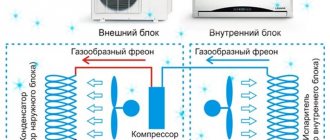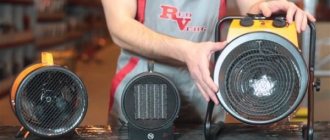The principle of operation of a heat gun, regardless of price, complexity of the device or any classification, is quite simple and, in fact, the same for both diesel or gas and electric guns.
A powerful fan drives cold air through heating elements or a combustion chamber, in which the air is heated and the same fan contributes to the even distribution of hot air throughout the room or open space.
The most common types of heat guns in use at the moment are electric, gas and diesel. Diesel engines, in turn, are divided into direct and indirect heating units.
In the first case (direct heating), the combustion products together with the incoming air are the coolant. Such guns are used either in open areas or in rooms with a good supply and exhaust ventilation system. Indirect heating devices are designed in such a way that combustion products do not enter the room, but are discharged outside it. Both diesel and gas guns require an electrical connection to power the fan, ignition system or security system.
Based on the principle of fuel injection, ejector and electromechanical guns are distinguished. The ejector principle is implemented as follows: the air flow created by the pump creates a vacuum and sucks fuel from the tank. Next, the air-fuel mixture is supplied through the nozzle into the combustion chamber. Electromechanical injection is carried out by installing a fuel pump and an air blower.
Operating principle of a gas heat gun
Using an electric motor, a fan is started, sucking cold air inside the gun. Fuel in the form of gas enters the burner through the reducer. Ignition occurs through a piezoelectric element (the safety of the unit is ensured by an automatic system with a temperature sensor that stops the gas supply if the flame goes out). The heated air flows passing through the gun are pushed out by a fan.
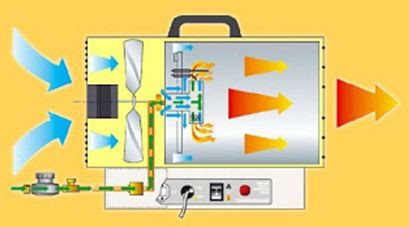
Some features of gas heat guns
- Possibility of quick connection and replacement of a gas cylinder
- Stable operation even in severe frost (in the worst case, you need to shake the cylinder)
- The efficiency of the device is close to 100%
It is important to remember that when the unit is operating, oxygen in the room is burned, so when heating the room there should be no people in the room, and after the unit has finished operating, ventilation is necessary.
Types of heat guns
Models with direct heating are distinguished by the fact that during operation they emit a combustion product directly into the operating area - this could be, for example, a production room or a construction site. Modifications with indirect heating provide for the removal of combustion products outside the boundary of the working object. Obviously, direct heating has serious limitations in terms of use. In particular, such equipment cannot be used in residential premises. In exchange for this inconvenience, the user receives better performance.
In turn, an indirectly heated diesel fuel heat gun can also be used in rooms where people are located. Its design includes a mechanism for removing combustion products, which is connected to the chimney channel through a special pipe. That is, during operation, heat flows get rid of the fumes, spreading throughout the room or workshop in a relatively pure form. True, the operation of such models also requires the organization of a ventilation system in the room, since the unit will process oxygen.
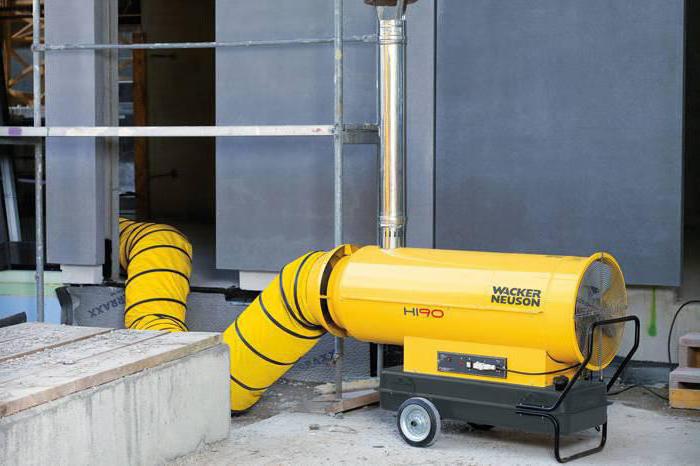
Gas supply diagram in a gas heat gun
|
After connecting the gas cylinder, the gas enters the gas inlet pipe (1), then into the flame extinguishing chamber (2), the solenoid valve (3), into the gas supply regulator valve (4), into the gas injector (5), then ignition (ignition) occurs from the spark plug.
The thermocouple (7) heats up and facilitates the passage of gas into the flame retardant chamber (2). The thermostat (8) starts the electrical circuit and allows gas to pass through the solenoid valve. Also, the thermostat (8) is responsible for blocking the gas supply (overheating protection).
Types of diesel heaters
Heat guns running on diesel fuel are represented in two large categories - direct and indirect heating devices. Let's see how the presented varieties differ from each other.
Direct heating heat guns
A direct heating diesel gun is the simplest source of thermal energy.
It is equipped with a completely open combustion chamber. Its heart is a pump with a nozzle, which generates a torch. There is a powerful fan behind it. The generated heat, along with combustion products, is sent to the heated room. That is, there is no separate chimney here, which is a big disadvantage. A direct heating heat gun is harmful to human health, so its operation in an unventilated area is prohibited (despite the almost complete combustion of diesel fuel). And even where there is good ventilation, people will be constantly haunted by the smell of burning - there is no escape from it. Such units are most often used in open areas where there is a flow of fresh air.
There are craftsmen who manage to convert direct-type guns into indirect-type units, which will be discussed later - they are safer.
Heat guns of indirect heating
Standing next to a direct-fired diesel heat gun is like smelling smoke from the tailpipe of a truck. Staying in a heated room for a long time can lead to severe headaches and poisoning.
Therefore, such units are used relatively rarely. But they came up with an excellent alternative. A diesel indirect heating heat gun is a more advanced and advanced device. In some ways it resembles a liquid fuel heating boiler. Only it does not heat the coolant, but the air. The basis of such a heat gun is the same nozzle - it is placed in a closed combustion chamber, equipped with a combustion product exhaust system (in other words, a chimney). The rest of the design is the same.
Due to the removal of combustion products to the outside, such units can be used to heat unventilated rooms. The pressurized air in these guns does not come into contact with the burning torch - it, as it were, blows over the combustion chamber. As for burning and soot, they go into the connected chimney and do not enter the premises. Thanks to this, indirectly heated diesel heat guns can be used in almost any conditions.
Despite the presence of exhaust of combustion products outside, for the operation of indirect (indirect) heating units, at least some kind of ventilation is still needed - oxygen for the operation of the burner is taken directly from the room.
Operating principle of a diesel heat gun (direct flow)

From the fuel tank of a diesel direct-flow gun, fuel (usually diesel fuel or kerosene) enters a special settling filter. Next, using a pump or compressor, the fuel enters the injector.
A fan located at the rear of the gun delivers cool air into the combustion chamber, while at the same time distributing fuel from the nozzle there. Ignition occurs via a spark plug and an electrical element. Hot air masses, together with combustion products, rush into the heated space.
Some features of diesel heat guns
- Economical fuel consumption (10-15 hours of continuous operation)
- Low energy costs (0.3-1 kW)
- In the case of direct heating, combustion products enter the heated space, so ventilation of the room is necessary
Types of heat guns
Heat fans are classified by the type of fuel/energy used. Heat guns can be divided into 3 broad categories:
- Liquid fuel
- Gas
- Electrical
It should be immediately noted that no matter what fuel/energy heat guns use, they still need access to a 220/380 (V) electrical network . Electricity is needed to rotate the fan blades. The only exception is infrared heaters. This technique heats surfaces not due to the flow of warm air, but due to radiation.
How to choose a heat gun.

Liquid fuel heat guns
Liquid fuel heaters include equipment that operates on:
- Diesel fuel
- Gasoline
- Kerosene
Diesel heat guns are considered the most powerful and productive. If we consider heaters from the standpoint of economic profitability, then kerosene fan heaters take the lead. Gasoline models provide average results, they are moderately economical due to high heat transfer, and are quite efficient.
multi-fuel heat guns have recently become widespread . Such heaters can use any flammable liquid instead of fuel.
Liquid heat guns are usually used in cases where it is necessary to provide a large area/volume room with long-term heating . It is cheaper to obtain heat by burning fuel than to spend electricity on heating.
What else you need to know about how to choose a heat gun.

Gas heat guns
Heaters of this type operate on liquefied gas (natural, propane, butene, etc.). This can be gas from cylinders or a centralized gas pipeline.
Gas-type heat guns are considered very economical and productive . The absence of a fuel tank heater in the design makes heat guns extremely compact and lightweight.
The main disadvantage of gas heat guns is the increased danger of operation . When using such guns, the technical condition of gas hoses should be carefully and regularly monitored. It is necessary to monitor the serviceability of the gas reducer.
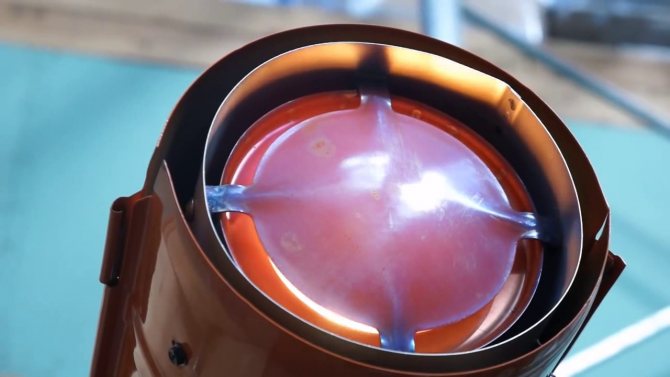
Electric heat guns
Heaters of this type are the most environmentally friendly and practical . This is a lightweight and compact equipment that does not require any special conditions during storage, transportation or operation.
The main disadvantage of electric-type heat guns is the high cost of the heat produced . 10 hours of operation of a 100-kilowatt electric heater can significantly reduce the economic profitability of repair and construction work.
The main advantage of electric heating is the ability to use a heat gun in a room with people . In this case, the heater does not need a chimney to remove combustion products.

Types of heat guns that are not included in the list of main ones
Of course, there are heat guns with a combined operating principle. Additionally, you can find heaters that run on waste oil, firewood, sawdust, and even leaves/hay. Such heaters almost always require the creation of a chimney. Most of these heat guns are installed permanently in the serviced premises.
A separate category of heat guns are the so-called infrared heaters . Infrared heating is good because it does not require the creation of an air flow, that is, it does not have a fan. Unlike classic heat guns, which warm up the entire room, infrared heaters can only affect certain surfaces.
The heat guns described above, among the additional ones, are for the most part highly specialized. They have not found widespread use, although they are in demand under certain conditions.
How to choose a heat gun based on operating parameters.

Operating principle of an electric heat gun

The cold air taken by the fan enters the gun and is heated there with the help of special heating elements (heating elements), and after that it is again thrown into the room.
Some features of electric heat guns
- The speed of passage of air masses through the heating system is high, so the heating efficiency directly depends on the power of the heating elements
- The speed of the air flow affects the uniformity of heating. The higher the speed, the more evenly the heat is distributed (while the heating itself occurs more slowly, since the air does not have time to heat up much)
- Electric heat guns are not intended for heating open areas. For these purposes, diesel or gas engines are used.
- During operation of the electric gun, no foreign odors are emitted (in the very first days of operation, a specific smell from the heating elements is possible, which soon disappears)
Advantages of heat guns
Equipment running on diesel fuel has a whole range of advantages. Since the device does not require connection to gas or electricity, it is distinguished by its autonomy and mobility provided by special wheels. With their help, the device can be moved to any convenient place. By using a diesel engine, high efficiency and productivity of the equipment is achieved.
Ease of operation and absolute safety are achieved due to the presence of a fume gas purification system, a thermostat that protects against overheating, a housing that is completely isolated from the heating elements, as well as a flame stabilization system.
A diesel gun, the price of which ranges from 40 thousand rubles and above, is intended for heating industrial premises, so you should not choose this device if you need to heat a house or apartment. As the main competitor of the gun in terms of heating large rooms, only one unit can be named - a solid fuel heating boiler. However, only a cannon is capable of heating a truly large room, as well as providing ventilation and air circulation.




